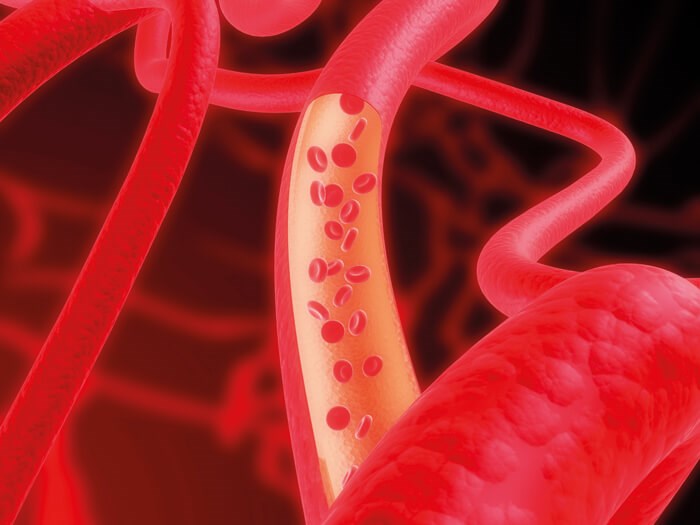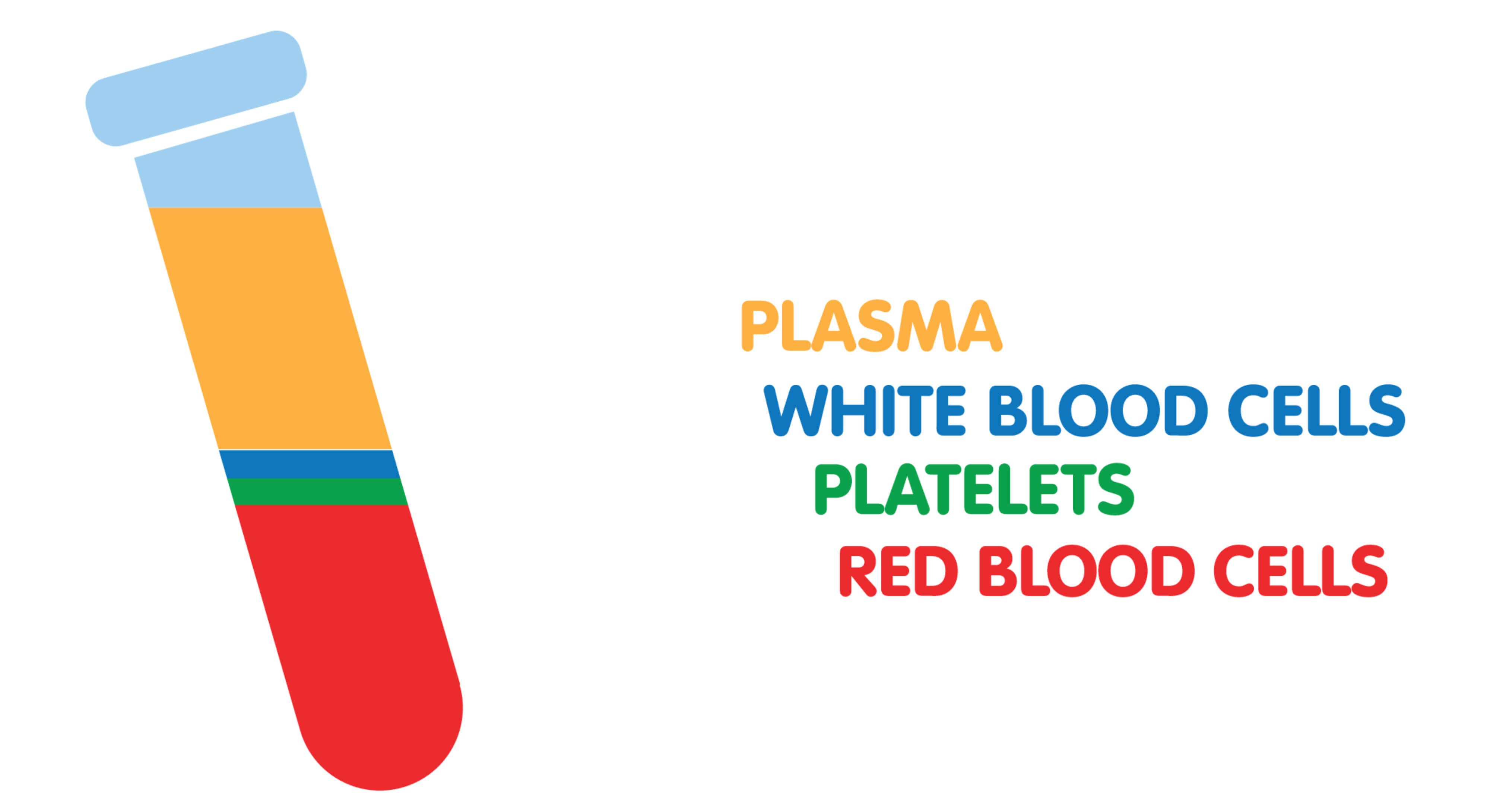Claudia McGloin provides an overview of this misunderstood procedure.
Platelet rich plasma treatment is commonly known as PRP, Dracula Therapy, Vampire Facial / Facelift, S3, Self-Stimulated Serum, Liquid Gold or Vampire Therapy. Platelet rich plasma has been around for a while but was catapulted into the media spotlight by Kim Kardashian when she famously had this procedure and featured it on her reality TV show.
Growth factors were first discovered by Stanley Cohen and Rita Levi-Montalcini in the 1950s when their research opened the door for platelet rich plasma. They were subsequently awarded a Nobel Prize for their work in 1986 [1].
Platelet rich plasma (PRP) is a procedure that is widely misunderstood, when it is actually a very powerful treatment that involves using the patient’s own blood to treat a variety of indications such as hair-loss, sports injuries, scars, sexual dysfunction, wound healing and tissue regeneration [2].

Figure 1: Red blood cells.

Figure 2: Composition of blood.
What is platelet rich plasma?
PRP is an autologous concentration of human platelets in a small volume of plasma which is developed from autologous blood, meaning that it is inherently safe and is defined as a sample of autologous blood with concentrations of platelets in a given volume of plasma that is above the concentration found in the whole blood [3,4].
Plasma, which comprises 55% of blood fluid, is mostly water (90% by volume), and contains dissolved proteins, glucose, mineral ions, hormones, carbon dioxide, platelets and blood cells. As PRP is a concentration of platelets, it is also a concentration of the seven fundamental protein growth factors proved to be actively secreted by platelets to initiate all wound healing. These growth factors include the three isomers of platelet-derived growth factor. All of these growth factors have been documented to exist in platelets but the platelets need to be activated. On activation, they will release alpha granules, within which those growth factors are stored [5].
In addition, the activated thrombocytes have a multitude of signal molecules on their surface: CD9, CD-W17, CD41, CD42a-d, CD51, CD-W60, CD61, CD62P, CD63. As these concentrated platelets are suspended in a small volume of plasma, PRP is more than just a platelet concentrate; it also contains the three proteins in blood known to act as cell adhesion molecules for osteo-conduction and as a matrix for bone, connective tissue and epithelial migration. These cell adhesion molecules are fibrin, fibronectin and vitronectin [6].
According to Ibrahim et al., PRP allows the body to heal faster and more efficiently [7]. It does this by stimulating DNA repair, which can heal wounds and remodel scars, lacklustre skin look and feel younger [8]. Not only is it an effective anti-ageing treatment, but it also has wider uses within the medical profession, as previously mentioned [9].
"Apart from sports injuries and orthopaedics, the treatment of alopecia is also hugely popular"
Platelets are the first responder to trauma in the body and by injecting these directly back into the site requiring treatment, we are tricking the body into thinking a trauma has occurred and the growth factors present will start to work immediately to stimulate and rejuvenate, aiding the body’s healing and repairing process [6,10].
How does PRP work?
Platelet rich plasma is prepared by first taking blood from the patient, then placing the blood in a centrifuge which spins the blood at high speed in order to separate the platelets from the red blood cells. There are three layers – PRP, platelet poor plasma (PPP) and red blood cells. The resulting small volume of fluid after the centrifugation process contains approximately five to seven times the normal volume of platelets.
After spinning, the PRP and PPP are taken from the tube and put into a syringe. The red blood cells are never injected. The PRP is then injected into the patient into the area that requires treatment. Following a PRP treatment, results are noticeable within three to four weeks and often only one procedure is required, however, this will be dependent on the kit used and the area to be treated [3].
PRP is a good treatment for rejuvenation as it is non-surgical, natural and relatively safe; it gives results that can last up to 12 months. As the platelets are autologous, there is no risk of infection or rejection.
There are a number of different PRP harvesting kits available, but some contain thrombin and therefore the end product cannot be categorised as autologous. Others use a chemical buffer to separate the plasma and red cells, and do not deliver pure PRP as a result. This can often lead to a difference in results and will in my opinion require further studies and research. Activation of the platelets is required for the release and enmeshment of growth factors, but the method of activation may influence the resulting matrix, growth factor availability and healing [11].
As mentioned previously, PRP is used to treat a variety of medical indications. Apart from sports injuries and orthopaedics, the treatment of alopecia is also hugely popular and there are a lot of case studies and research to support this, as opposed to facial rejuvenation which doesn’t appear to have as many.
What can PRP be used for?
- Wound healing
- Scars and stretch marks
- Hairloss
- Facial rejuvenation
- Sports injuries / orthopaedics
- Vagina rejuvenation (sexual dysfunction)
- Dental surgery
- Plastic surgery
- Cardiac surgery
- New trial: Respiratory conditions (USA)
PRP can be used as a stand-alone procedure or used in combination with other aesthetic medicine procedures such as dermal fillers, mesotherapy, laser, micro needling and PDO threads.
Conclusion
Platelet rich plasma is a procedure that can be used as a stand-alone treatment or in combination with other procedures. It is a relatively safe and natural procedure, as the platelets are taken from the patient’s own blood, therefore posing no risk of infection or rejection. PRP can be used to treat a variety of indications successfully.
While there are hundreds of research papers into the effectiveness of PRP, further research is required on treating indications such as facial rejuvenation and also whether PRP requires activation prior to injection. On the whole, the treatment speaks for itself. PRP is a procedure that naturally heals and repairs the body.
PRP is misunderstood and is not a new procedure or beauty fad as some may have believed.
References
1. DL Villela, VL Santos. Evidence of the use of platelet-rich plasma for diabetic ulcer: a systematic review. Growth Factors 2010;2:111-6.
2. Shahid M, Kundra R. Platelet-rich plasma (PRP) for knee disorders. EFORT Open Rev 2017;2(1):28-34.
3. Daniel Sister: PRP Platelet Rich Plasma: The New Frontier in Regenerative and Aesthetic Medicine. Officina Editoriale Oltrarno: Italy; 2016.
4. Mishra A. Platelet Rich Plasma. Orthopaedics 2010;33(7):486-7.
5. Kim DH, Je YJ, Kim CD, et al. Can platelet-rich plasma be used for skin rejuvenation? Evaluation of effects of platelet-rich plasma on human dermal fibroblast. Ann Dermatol 2011;23(4):424-31.
6. Everts PA, Knape JT, Weibrich G, et al. Platelet-rich plasma and platelet gel: a review. J Extra Corpor Technol 2006;38(2):174-87.
7. Ibrahim ZA, El-Tatawy RA, El-Samongy MA, Ali DA. Comparison between the efficacy and safety of platelet-rich plasma vs. microdermabrasion in the treatment of striae distensae: clinical and histopathological study. J Cosmet Dermatol 2015;14(14):336-46.
8. Cervelli V, Gentile P, Scioli MG, et al. Application of platelet-rich plasma in plastic surgery: clinical and in vitro evaluation. Tissue Eng Part C Methods 2009;15(4):625-34.
9. Amgar G Bouhanna P. Platelet Rich Plasma: a therapy for hair growth. Prime Journal June 2013:20-31.
10. Nathan Wei: The Book On PRP. 2012.
11. Sommeling CE, Heyneman A, Hoeksema H, et al. Use of platelet-rich plasma in plastic surgery: a systemetic review. J Plast Reconstr Aesthet Surg 2013;66(3):301-11.
COMMENTS ARE WELCOME






